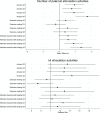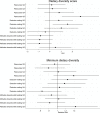Associations between women's empowerment and child development, growth, and nurturing care practices in sub-Saharan Africa: A cross-sectional analysis of demographic and health survey data
- PMID: 34529666
- PMCID: PMC8483356
- DOI: 10.1371/journal.pmed.1003781
Associations between women's empowerment and child development, growth, and nurturing care practices in sub-Saharan Africa: A cross-sectional analysis of demographic and health survey data
Abstract
Background: Approximately 40% of children 3 to 4 years of age in low- and middle-income countries have suboptimal development and growth. Women's empowerment may help provide inputs of nurturing care for early development and growth by building caregiver capacity and family support. We examined the associations between women's empowerment and child development, growth, early learning, and nutrition in sub-Saharan Africa (SSA).
Methods and findings: We pooled data on married women (15 to 49 years) and their children (36 to 59 months) from Demographic and Health Surveys that collected data on child development (2011 to 2018) in 9 SSA countries (N = 21,434): Benin, Burundi, Cameroon, Chad, Congo, Rwanda, Senegal, Togo, and Uganda. We constructed a women's empowerment score using factor analysis and assigned women to country-specific quintile categories. The child outcomes included cognitive, socioemotional, literacy-numeracy, and physical development (Early Childhood Development Index), linear growth (height-for-age Z-score (HAZ) and stunting (HAZ <-2). Early learning outcomes were number of parental stimulation activities (range 0 to 6) and learning resources (range 0 to 4). The nutrition outcome was child dietary diversity score (DDS, range 0 to 7). We assessed the relationship between women's empowerment and child development, growth, early learning, and nutrition using multivariate generalized linear models. On average, households in our sample were large (8.5 ± 5.7 members) and primarily living in rural areas (71%). Women were 31 ± 6.6 years on average, 54% had no education, and 31% had completed primary education. Children were 47 ± 7 months old and 49% were female. About 23% of children had suboptimal cognitive development, 31% had suboptimal socioemotional development, and 90% had suboptimal literacy-numeracy development. Only 9% of children had suboptimal physical development, but 35% were stunted. Approximately 14% of mothers and 3% of fathers provided ≥4 stimulation activities. Relative to the lowest quintile category, children of women in the highest empowerment quintile category were less likely to have suboptimal cognitive development (relative risk (RR) 0.89; 95% confidence interval (CI) 0.80, 0.99), had higher HAZ (mean difference (MD) 0.09; 95% CI 0.02, 0.16), lower risk of stunting (RR 0.93; 95% CI 0.87, 1.00), higher DDS (MD 0.17; 95% CI 0.06, 0.29), had 0.07 (95% CI 0.01, 0.13) additional learning resources, and received 0.16 (95% CI 0.06, 0.25) additional stimulation activities from their mothers and 0.23 (95% CI 0.17 to 0.29) additional activities from their fathers. We found no evidence that women's empowerment was associated with socioemotional, literacy-numeracy, or physical development. Study limitations include the possibility of reverse causality and suboptimal assessments of the outcomes and exposure.
Conclusions: Women's empowerment was positively associated with early child cognitive development, child growth, early learning, and nutrition outcomes in SSA. Efforts to improve child development and growth should consider women's empowerment as a potential strategy.
Conflict of interest statement
The authors have declared that no competing interests exist.
Figures






Similar articles
-
Association Between Women's Empowerment and Maternal and Child Nutrition in Kalalé District of Northern Benin.Food Nutr Bull. 2017 Sep;38(3):302-318. doi: 10.1177/0379572117704318. Epub 2017 Apr 26. Food Nutr Bull. 2017. PMID: 28443373
-
What does women's empowerment have to do with malnutrition in Sub-Saharan Africa? Evidence from demographic and health surveys from 30 countries.Glob Health Res Policy. 2020 Jan 14;5:1. doi: 10.1186/s41256-019-0129-8. eCollection 2020. Glob Health Res Policy. 2020. PMID: 31956697 Free PMC article.
-
Association between women's empowerment and infant and child feeding practices in sub-Saharan Africa: an analysis of Demographic and Health Surveys.Public Health Nutr. 2015 Dec;18(17):3155-65. doi: 10.1017/S1368980015002621. Epub 2015 Sep 8. Public Health Nutr. 2015. PMID: 26347195 Free PMC article.
-
Evidence of Impact of Interventions on Growth and Development during Early and Middle Childhood.In: Bundy DAP, Silva ND, Horton S, Jamison DT, Patton GC, editors. Child and Adolescent Health and Development. 3rd edition. Washington (DC): The International Bank for Reconstruction and Development / The World Bank; 2017 Nov 20. Chapter 7. In: Bundy DAP, Silva ND, Horton S, Jamison DT, Patton GC, editors. Child and Adolescent Health and Development. 3rd edition. Washington (DC): The International Bank for Reconstruction and Development / The World Bank; 2017 Nov 20. Chapter 7. PMID: 30212122 Free Books & Documents. Review.
-
Improving women's nutrition imperative for rapid reduction of childhood stunting in South Asia: coupling of nutrition specific interventions with nutrition sensitive measures essential.Matern Child Nutr. 2016 May;12 Suppl 1(Suppl 1):72-90. doi: 10.1111/mcn.12255. Matern Child Nutr. 2016. PMID: 27187909 Free PMC article. Review.
Cited by
-
Fathers' experiences of childcare and feeding: A photo-elicitation study in a low resource setting in urban Addis Ababa, Ethiopia.PLoS One. 2023 Jul 21;18(7):e0288487. doi: 10.1371/journal.pone.0288487. eCollection 2023. PLoS One. 2023. PMID: 37478156 Free PMC article.
-
Is child anemia associated with early childhood development? A cross-sectional analysis of nine Demographic and Health Surveys.PLoS One. 2024 Feb 28;19(2):e0298967. doi: 10.1371/journal.pone.0298967. eCollection 2024. PLoS One. 2024. PMID: 38416752 Free PMC article.
-
Union formation, within-couple dynamics, and child well-being: A global macrolevel perspective.Popul Space Place. 2023 Jul;29(5):e2661. doi: 10.1002/psp.2661. Epub 2023 Apr 18. Popul Space Place. 2023. PMID: 37635738 Free PMC article.
-
Women's Empowerment and Associated Factors in Kinshasa, Democratic Republic of Congo: A Secondary Data Analysis of the Performance Monitoring Assessment Survey.Int J Environ Res Public Health. 2024 Jul 19;21(7):943. doi: 10.3390/ijerph21070943. Int J Environ Res Public Health. 2024. PMID: 39063518 Free PMC article.
-
Rural-urban differentials in women empowerment and experience of under-five mortality among mothers in Nigeria: a Multiple Indicator Survey analysis.BMC Public Health. 2025 Jul 2;25(1):2208. doi: 10.1186/s12889-025-23412-w. BMC Public Health. 2025. PMID: 40604555 Free PMC article.
References
-
- United Nations Children’s Fund (UNICEF), World Health Organization (WHO), International Bank for Reconstruction and Development/The World Bank, World Health Organization, International Bank for Reconstruction and Development/The World Bank. Levels and trends in child malnutrition: key findings of the 2020 Edition of the Joint Child Malnutrition Estimates 2020.
-
- Adair LS, Fall CH, Osmond C, Stein AD, Martorell R, Ramirez-Zea M, et al.. Associations of linear growth and relative weight gain during early life with adult health and human capital in countries of low and middle income: findings from five birth cohort studies. Lancet. 2013;382:525–34. doi: 10.1016/S0140-6736(13)60103-8 - DOI - PMC - PubMed
MeSH terms
LinkOut - more resources
Full Text Sources
Medical
Research Materials

